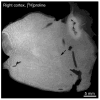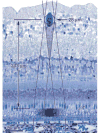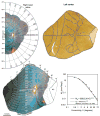Shadows cast by retinal blood vessels mapped in primary visual cortex
- PMID: 12386328
- PMCID: PMC3155987
- DOI: 10.1126/science.1074887
Shadows cast by retinal blood vessels mapped in primary visual cortex
Abstract
The mammalian eye is a remarkable optical device, but its design is not perfect. The blood vessels that supply the inner retina are located in front of the photoreceptor layer, blocking access to light. Their shadows create a pattern of blindness in the field of vision that corresponds precisely to the location of the largest vessels in the eye. We show here that in squirrel monkeys, focal deprivation by blood vessels leads to rewiring of the eye's geniculocortical projections, imprinting an image of the retinal vascular tree onto the primary visual cortex. This process illustrates vividly that local imbalances in neuronal activity can influence column formation during normal development.
Figures







Comment in
-
Blood vessels casting a shadow.Science. 2003 Mar 28;299(5615):1983-5; author reply 1983-5. doi: 10.1126/science.299.5615.1983. Science. 2003. PMID: 12663898 No abstract available.
References
Publication types
MeSH terms
Substances
Grants and funding
LinkOut - more resources
Full Text Sources
Other Literature Sources
Miscellaneous

